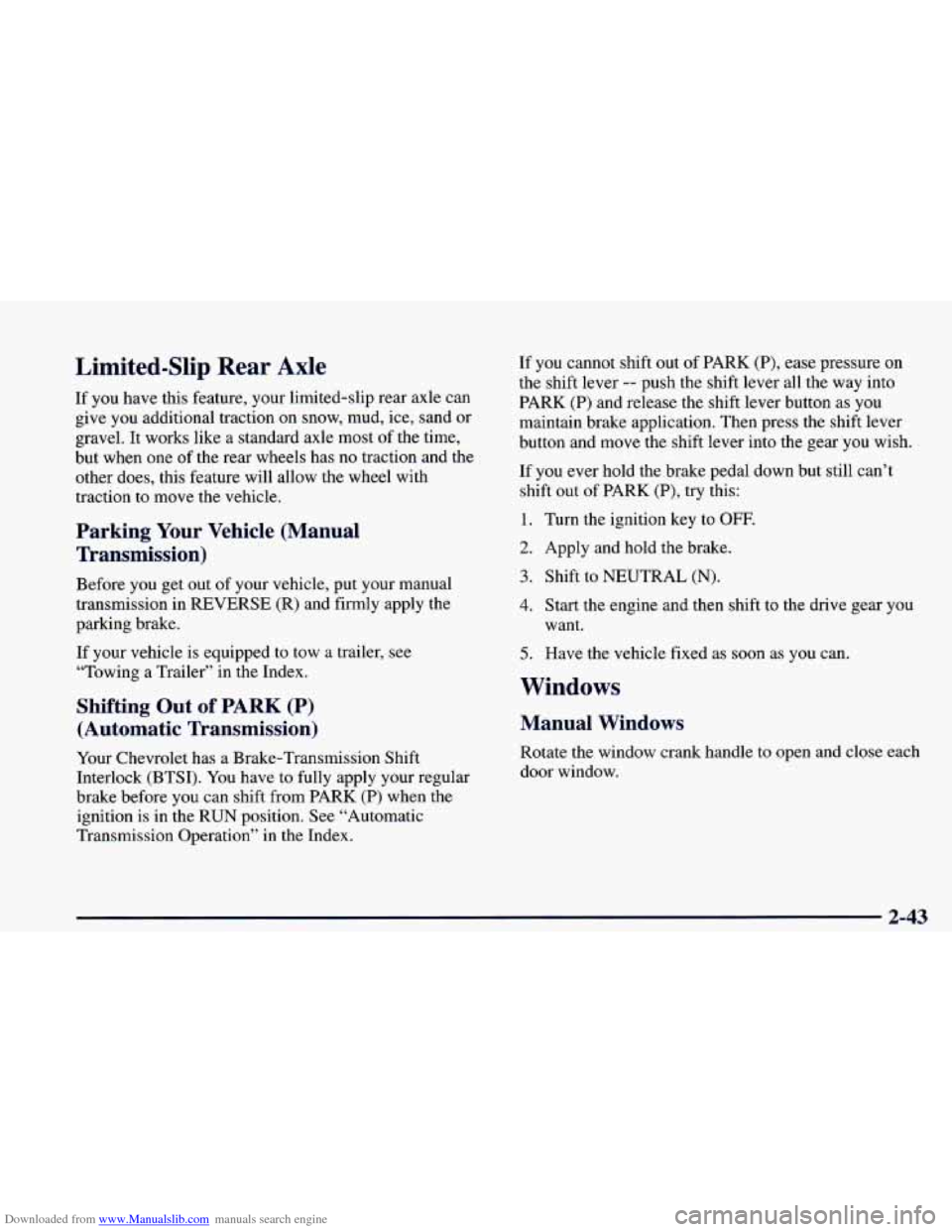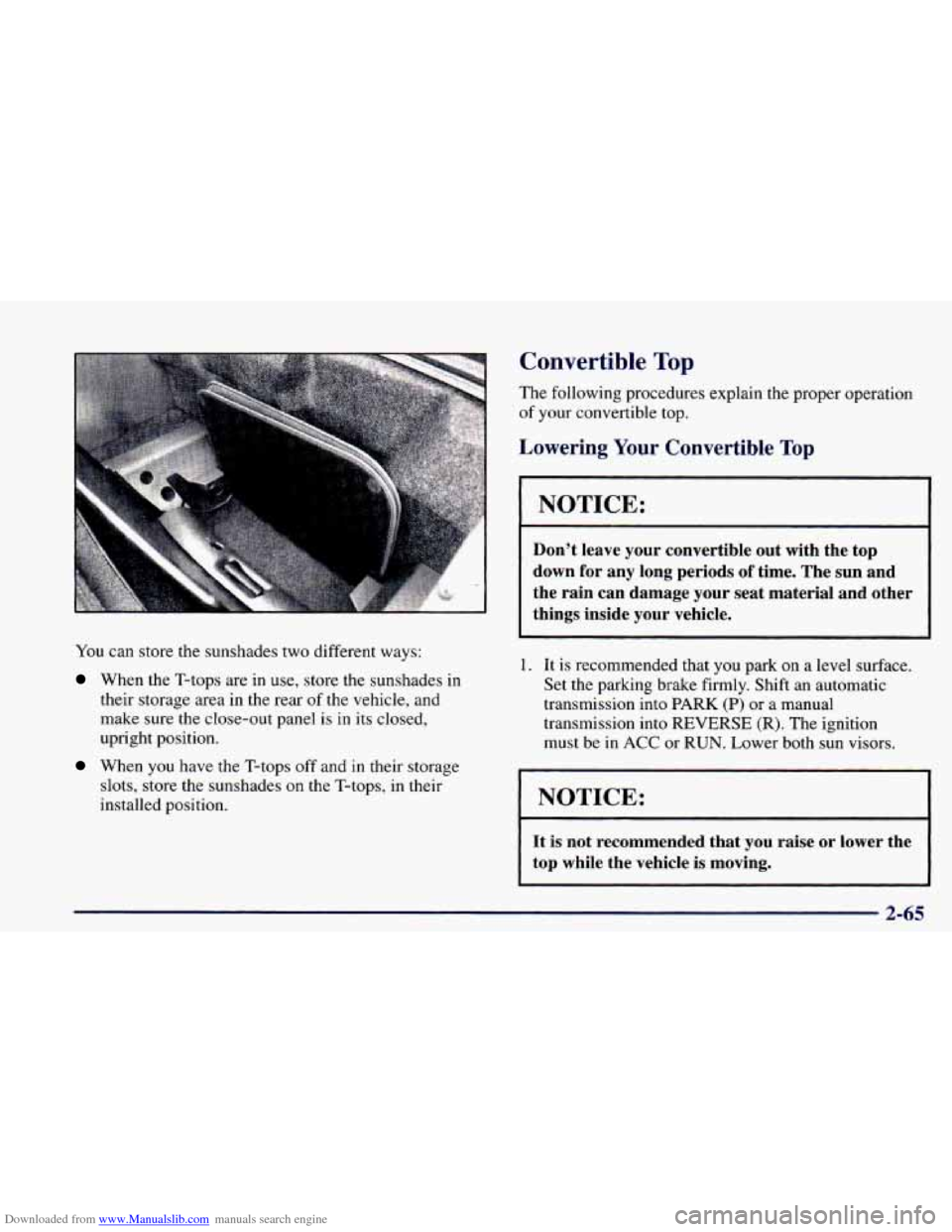1998 CHEVROLET CAMARO automatic transmission
[x] Cancel search: automatic transmissionPage 101 of 402

Downloaded from www.Manualslib.com manuals search engine FIRST (1): This position gives you even more power
(but lower fuel economy) than
SECOND (2). You can-
use it on very steep hills, or in deep snow or mud. If the
selector lever is put in
FIRST (1) gear, the transmission
won’t shift into first gear until the vehicle is going
slowly enough.
NOTICE:
If your rear wheels can’t rotate, don’t try to
drive.
This might happen if you were stuck in
very deep sand or mud or were up against
a solid
object. You could damage your transmission.
Also,
if you stop when going uphill, don’t hold
your vehicle there with only the accelerator
pedal. This could overheat and damage the
transmission. Use your brakes or shift into
PARK (P) to hold your vehicle in position
on
a hill.
Maximum engine speed is limited to protect driveline
components from improper operation.
Second-Gear Start (V6 Automatic)
(If Equipped)
Your vehicle may be
equipped with a
Second-Gear Start feature.
Press the Second Gear
Start (SGS) switch on the
instrument panel to provide
more traction when you are
starting on ice or other
slippery surfaces.
The light on the switch will illuminate when Second
Gear Start (SGS) is selected. The transmission will be
in
SECOND (2) gear when the vehicle begins to
move. After starting in
SECOND (2), the vehicle will
upshift normally.
This feature is only for improved traction when the road
surface is slippery and is not intended for continuous
use. Always use
NORMAL Second Gear Start (SGS)
“OFF” for normal road conditions. You may press the
Second Gear Start (SGS) switch again to turn
off this
feature. The light
on the switch will go out. Whenever
you start your vehicle, the transmission is in the
NORMAL mode.
2-33
Page 107 of 402

Downloaded from www.Manualslib.com manuals search engine Shifting Into PARK (P)
(Automatic Transmission Only)
A CAUTION:
It can be dangerous to get out of your vehicle if
the shift lever is not fully in PARK (P) with the
parking brake firmly set. Your vehicle can roll.
If
you have left the engine running, the vehicle can
move suddenly. You or others could be injured.
To be sure your vehicle won’t move, even when
you’re on fairly level ground, use the steps that
follow.
If you’re pulling a trailer, see “Towing a
Trailer” in the Index.
., .,. ..
..
1.
2.
3.
4.
Hold the brake pedal down with your right foot and
set the parking brake.
Move the shift lever into the PARK
(P) position by
holding in the button on the lever and push the lever
all the way toward the front
of your vehicle.
Move the ignition key to the
LOCK position.
Remove the key and take it with you.
If you can
leave your vehicle with the key in your hand, your
vehicle
is in PARK (P).
2-39
Page 108 of 402

Downloaded from www.Manualslib.com manuals search engine Leaving Your Vehicle With the Engine
Rum
lg (Automatic Transmission Only)
I
It can be dangerous to leave your vehicle with
the engine running. Your vehicle could move
suddenly if the shift lever is not fully in PARK
(P)
with the parking brake firmly set. And, if you
leave the vehicle with the engine running, it could
overheat and even catch fire. You
or others could
be injured. Don’t leave your vehicle with the
engine running unless you have to.
Torque Lock (Automatic Transmission)
If you are parking on a hill and you don’t shift your
transmission into PARK
(P) properly, the weight of the
vehicle may put too much force on the parking pawl in
the transmission. You may find it difficult to pull the
shift lever out
of PARK (P). This is called “torque lock.”
To prevent torque lock, set the parking brake and then
shift into PARK (P) properly before you leave the
driver’s seat.
To find out how, see “Shifting Into
PARK (P)” in the Index.
When you are ready to drive, move the shift lever out
of PARK (P) before you release the parking brake.
If torque lock does occur, you may need to have another
vehicle push yours a little uphill to take some of the
pressure from the parking pawl in the transmission,
so
you can pull the shift lever out of PARK (P).
2-40
Page 110 of 402

Downloaded from www.Manualslib.com manuals search engine Running Your Engine While You’re
Parked (Automatic Transmission)
It’s better not to park with the engine running. But if you
ever have to, here are some things to know.
Idling the engine with the climate control
system
off could allow dangerous exhaust into
your vehicle (see the earlier Caution under
“Engine Exhaust”).
Also, idling in a closed-in place can let deadly
carbon monoxide
(CO) into your vehicle even if
the fan switch is at the highest setting. One place
this can happen is
a garage. Exhaust -- with
CO -- can come in easily. NEVER park in a
garage with the engine running.
Another closed-in place can be a blizzard. (See
“Blizzard” in the Index.)
A -AUTION:
It can be dangerous to get out of your vehicle if
the shift lever is not fully in PARK (P) with the
parking brake firmly set. Your vehicle can roll.
Don’t leave your vehicle when the engine is
running unless you have
to. If you’ve left the
engine running, the vehicle can move suddenly.
You or others could be injured.
To be sure your
vehicle won’t move, even when you’re on fairly
level ground, always set your parking brake and
move the shift lever to
PARK (P).
Follow the proper steps to be sure your vehicle won’t
move. See “Shifting Into
PARK (P)” in the Index.
If you are parking on a hill and if you’re pulling a
trailer, also see “Towing a Trailer” in the Index.
2-42
Page 111 of 402

Downloaded from www.Manualslib.com manuals search engine Limited-Slip Rear Axle
If you have this feature, your limited-slip rear axle can
give you additional traction on snow, mud, ice, sand or
gravel. It works like a standard axle most of the time,
but when one of the rear wheels has no traction and the
other does, this feature will allow the wheel with
traction to move the vehicle.
Parking Your Vehicle (Manual
Transmission)
Before you get out of your vehicle, put your manual
transmission in REVERSE (R) and firmly apply the
parking brake.
If your vehicle is equipped to tow a trailer, see
“Towing a Trailer” in the Index.
Shifting Out of PARK (P)
(Automatic Transmission)
Your Chevrolet has a Brake-Transmission Shift
Interlock (BTSI). You have to fully apply your regular
brake before you can shift from PARK
(P) when the
ignition
is in the RUN position. See “Automatic
Transmission Operation’’ in the Index. If you cannot shift
out of PARK
(P), ease pressure on
the shift lever
-- push the shift lever all the way into
PARK
(P) and release the shift lever button as you
maintain brake application. Then press the shift lever
button and move the shift lever into the gear you wish.
If
you ever hold the brake pedal down but still can’t
shift out of PARK
(P), try this:
1. Turn the ignition key to OFF.
2. Apply and hold the brake.
3. Shift to NEUTRAL (N).
4. Start the engine and then shift to the drive gear you
want.
5. Have the vehicle fixed as soon as you can.
Windows
Manual Windows
Rotate the window crank handle to open and close each
door window.
2-43
Page 116 of 402

Downloaded from www.Manualslib.com manuals search engine When you apply your brakes, or push the clutch pedal,
if you have a manual transmission, the cruise control
shuts off. Setting Cruise Control
‘
A CAUTION:
r rn
Cruise control can be dangerous where you
can’t drive safely at a steady speed.
So,
don’t use your cruise control on winding
roads or in heavy traffic.
slippery roads. On such roads, fast changes
in tire traction can cause needless wheel
spinning, and you could lose control. Don’t
use cruise control on slippery roads.
Cruise control can be dangerous on
If ?oafvehicle is in cruise control when the optional
ASR system begins to limit wheel spin, the cruise
control will automatically disengage. (See
“ASR
System’’ in the Index.) When road conditions allow
you to safely use it again, you may
turn the cruise
control back on.
A!!
If you leave your cruise control switch on when
you’re not using cruise, you might hit
a button
and go into cruise when you don’t want to. You
could be startled and even lose control. Keep the
cruise control switch
off until you want to use it.
1. Move the cruise control switch to ON.
2. Get up to the speed you want.
3. Push in the SET button at the end of the lever and
release it.
4. Take your foot off the accelerator pedal.
2-48
Page 125 of 402

Downloaded from www.Manualslib.com manuals search engine Removing the Close-Out Panel
1. Close the panel. If the close-out panel is not closed
and resting on the trim panel, it cannot be removed.
2. Pull the panel toward you to unsnap it. Then slide the
close-out panel along the groove in the trim panel.
Reverse the steps to install the panel. An improperly stored close-out panel could be
thrown about the vehicle during
a collision or
sudden maneuver.
You or others could be
injured.
If you remove the cover, always store it
outside your vehicle. When you put it back,
always be sure that it
is securely reattached.
I
_T and Lighter
Lift up the cover to open the ashtray. To remove it,
lift up on the right side
of the ashtray. If you have an
automatic transmission, the ashtray is near the front of
your console. If you have a manual transmission, the
ashtray is near your cupholder.
I NOTICE:
When carrying large or heavy items, it is a good idea to
open the panel and place the items in the rear area. Don’t put papers and other things that burn into
your ashtrays.
If you do, cigarettes or other smoking
materials could
set them on fire, causing damage.
2-57
Page 133 of 402

Downloaded from www.Manualslib.com manuals search engine You can store the sunshades two different ways:
When the T-tops are in use, store the sunshades in
their storage area in the rear
of the vehicle, and
make sure the close-out panel
is in its closed,
upright position.
When you have the T-tops off and in their storage
slots, store the sunshades
on the T-tops, in their
installed position.
Convertible Top
The following procedures explain the proper operation
of your convertible top.
Lowering Your Convertible Top
NOTICE:
Don’t leave your convertible out with the top
down
for any long periods of time. The sun and
the rain can damage your seat material and other things inside your vehicle.
1. It is recommended that you park on a level surface.
Set the parking brake firmly. Shift an automatic
transmission into PARK
(P) or a manual
transmission into REVERSE (R). The ignition
must be in
ACC or RUN. Lower both sun visors.
I NOTICE:
It is not recommended that you raise or lower the
top while the vehicle is moving.
2-65